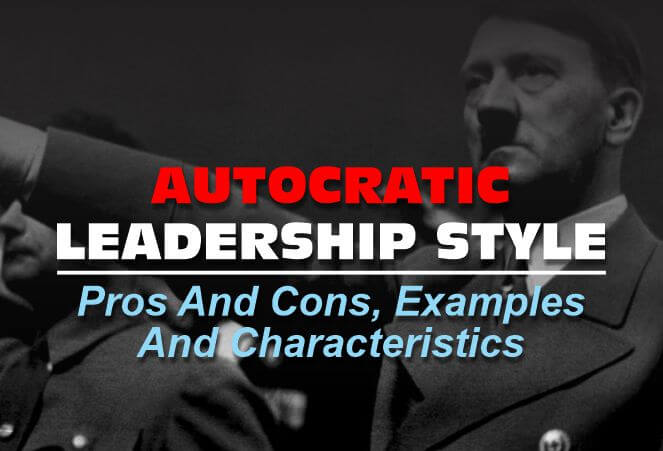Last updated on January 10th, 2024 at 11:40 pm
While the autocratic leadership style can be effective in certain situations, it is also widely criticized for being outdated, ineffective, and even harmful to the morale and motivation of team members.
Among all the leadership styles, this style of leadership is the stiffest and most self-centered kind of leadership for some reasons.
In this blog post, we will explore the concept of autocratic leadership, its characteristics, pros and cons, and how it compares to other styles of leadership.
What is autocratic leadership style?

Autocratic leadership is a style of leadership where the leader makes decisions on behalf of their team or organization without any input from subordinates.
The autocratic leader is commanding, decisive, and responsible for making all decisions.
Related: Quiet Leadership: The Power Of Being A Silent Leader
This style of leadership is often characterized by a lack of input from the employees or team in the decision-making process, as the leader generally makes all decisions alone.
It practices a top-down approach, where the leader exercises complete control over their team, issuing directives, and enforcing them without any discussion or collaboration.
Related: How to take Leadership in Relationships
A brief history of autocratic leadership style
The concept of autocratic leadership dates back to ancient times when kings and emperors ruled over their kingdoms with absolute authority.
It continues to be the dominant leadership style well into the modern era, with many political and military leaders adopting this approach to achieve their goals.
One notable example of autocratic leadership in history is the reign of Louis XIV of France, who famously said, “I am the state.”
Louis XIV ruled over France for over 70 years, exercising absolute power over his subjects and implementing a range of reforms to strengthen the monarchy and centralize power.
Another well-known example of autocratic leadership is that of Adolf Hitler, who rose to power in Germany in the 1930s and implemented a totalitarian regime characterized by strict control over all aspects of society, persecution of minority groups, and aggressive foreign policy.
In modern times, it has become less prevalent as democracy and human rights have become more widespread.
However, some political leaders in countries with authoritarian regimes continue to adopt an autocratic leadership style, suppressing dissent and opposition through force and coercion.
In the business world, autocratic leadership is sometimes used by CEOs and other high-level executives to maintain control over their organizations and ensure that their vision is implemented without deviation.
Characteristics of autocratic leadership style
Autocratic leaders typically have a clear vision of what they want to achieve and how they plan to get there.
They are often charismatic and have strong personalities, which allows them to inspire and motivate their team members.
However, this type of leaders also tends to be controlling and demanding, with little regard for the opinions or feelings of their subordinates.
The key characteristics of the autocratic leadership style include:
Centralized decision-making: They make decisions on behalf of their team or organization without any input from subordinates. They believe that they are the only ones capable of making the right decisions and that their subordinates lack the knowledge, experience, or expertise to contribute meaningfully.
Strict control: They maintain strict control over their team or organization, often using fear and intimidation to enforce their will.
They micromanage their subordinates, monitor their performance closely, and punish them for any mistakes or failures.
Little room for creativity: Autocratic leaders do not encourage creativity or innovation among their subordinates. They prefer to stick to traditional methods and practices and do not tolerate any deviation from the norm.
High pressure: Autocratic leaders put a lot of pressure on their subordinates to perform at their best.
They set high standards and expectations and demand that their team members meet them.
Pros and cons of the autocratic leadership style
This style has both advantages and disadvantages, which are discussed below:
Quick decision-making: They can make decisions quickly, without wasting time on consultation or discussion. This can be useful in situations where time is of the essence, such as in a crisis.
Clear direction: Autocratic leaders provide clear direction to their team or organization, which can help to avoid confusion and ensure that everyone is on the same page.
Accountability: Autocratic leaders hold their subordinates accountable for their actions and decisions, which can promote a culture of responsibility and discipline.
However, autocratic leadership also has some significant drawbacks, including:
Low morale: Autocratic leaders can demotivate their team members by failing to recognize their contributions or by being overly critical.
This can lead to low morale, high turnover, and a lack of commitment to the organization.
Lack of creativity: They do not encourage creativity or innovation among their subordinates, which can lead to stagnation and a lack of progress over time.
Resistance to change: Autocratic leaders may resist change or new ideas that come from their subordinates, which can limit the organization’s ability to adapt and grow.
Autocratic leadership style examples

There are many examples of autocratic leadership styles in practice, both in history and in modern times. Here are a few notable examples:
Napoleon Bonaparte: Napoleon is often cited as one of the most famous autocratic leaders in history.
As Emperor of France, he exercised absolute control over his subjects and made all major decisions without input from others.
Lee Kuan Yew: The founding father of modern Singapore, Lee Kuan Yew was known for his autocratic leadership style.
He believed that Singapore needed a strong leader to guide its development, and he made all major decisions himself, without much input from others.
Steve Jobs: The late Apple CEO Steve Jobs was known for his autocracy, which he believed was necessary to maintain Apple’s high standards for innovation and quality.
Jobs was notorious for making all major decisions himself and for being extremely demanding of his employees.
Donald Trump: As President of the United States, Donald Trump was often criticized for his autocracy. He frequently made decisions without consulting with others and was known for his combative approach to politics and governance.
Jeff Bezos: As the founder and CEO of Amazon, Jeff Bezos has been known to have an autocratic leadership style.
Bezos is known for being extremely hands-on in the company’s day-to-day operations and for making all major decisions himself.
Autocratic leadership vs. Other leadership styles
Autocratic leadership is just one of many different leadership styles, each with its own strengths and weaknesses. Some of the other leadership styles include:
Democratic leadership: In this style of leadership, the leader involves subordinates in decision-making and encourages collaboration and discussion.
Transformational leadership: This style of leadership focuses on inspiring and motivating subordinates to achieve their full potential, rather than just issuing directives.
Laissez-faire leadership: This style of leadership is hands-off.
Criticisms and controversies surrounding autocratic leadership
Autocratic leadership has faced a number of criticisms and controversies over the years. Some of these include:
Lack of creativity and innovation: It often stifle creativity and innovation by not allowing individuals to express their ideas and provide feedback.
Low morale among subordinates: It can create a culture of fear and low morale among subordinates due to the emphasis on hierarchy and authority.
Limited perspective: Autocratic leaders may have a limited perspective as they do not seek input or opinions from others, leading to missed opportunities or blind spots.
Dependency on the leader: This can create a dependency on the leader, leaving individuals unable to make decisions or take initiative without approval from the leader.
Resistance to change: Autocratic leaders may resist change or new ideas, leading to an inflexible and stagnant organization.
Lack of trust: Autocratic leadership can erode trust between the leader and subordinates as individuals may feel they are not being heard or valued.
Ineffective in complex situations: In complex situations that require collaboration and decision-making from multiple perspectives, autocratic leadership may not be effective as it relies on a single person’s perspective and decision-making.
Ethical concerns: Autocratic leaders may prioritize their own interests or the interests of a select few over the well-being of the organization or its stakeholders, leading to ethical concerns.
Wrapping up
While autocratic leadership can be effective in some situations, it can also be detrimental to organizational morale and creativity.
It’s important for leaders to consider the potential drawbacks of this type of leadership and to find a balance between control and collaboration.
Frequently asked questions
What is the autocratic leadership style?
Autocratic leadership is a leadership approach where the leader has complete control over decision-making and uses a top-down management approach.
This style is characterized by a lack of input from subordinates and a focus on authority, control, and rules.
Is autocratic leadership style effective?
Autocratic leadership can be effective in certain situations, such as in emergency situations where quick decision-making is necessary.
However, it can also be detrimental to organizational morale and creativity. Research suggests that this leadership style can lead to low job satisfaction and high turnover rates.
What are the pros of autocratic leadership style?
The pros of autocratic leadership include quick decision-making, clear direction, accountability, and structure.
In situations where time is of the essence, this type of leadership can be effective.
What are the cons of autocratic leadership style?
The cons of autocratic leadership include low morale, lack of creativity, resistance to change, and negative impact on team dynamics.
Autocratic leaders can stifle creativity and innovation by limiting input from subordinates, leading to a lack of engagement and low morale.
How can leaders balance autocratic leadership with collaboration?
Leaders can balance autocratic leadership with collaboration by involving subordinates in decision-making processes and seeking feedback and input from others.
This can help to build trust, engagement, and buy-in from employees.
Is autocratic leadership style ethical?
Autocratic leadership can raise ethical concerns, particularly when it is used to suppress dissent or limit individual freedoms.
It is important for leaders to consider the potential impact of their leadership style on employees and stakeholders and to ensure that their decisions align with ethical standards.
It differs from other leadership styles such as democratic, transformational, and laissez-faire leadership.
Democratic leadership style involves shared decision-making and collaboration, while transformational leadership focuses on inspiring and motivating employees.
Laissez-faire leadership involves giving subordinates a high degree of autonomy and decision-making power.
SOURCES:
- Effects Of Autocratic Leadership
- The Autocratic Leadership Style And Why It Doesn’t Work
- Autocratic Leadership
Pious Clements is the insightful voice behind "The Conducts of Life" blog, where he writes about life ethics, self-development, life mastery, and the dynamics of people and society.
With a profound understanding of human behaviuor and societal dynamics, Pious offers thought-provoking perspectives on ethical living and personal growth.
Through engaging narratives and astute observations, he inspires readers to navigate life's complexities with wisdom and integrity, encouraging a deeper understanding of the human experience and our place within society.

